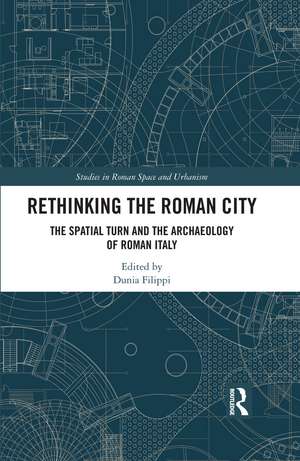Rethinking the Roman City: The Spatial Turn and the Archaeology of Roman Italy: Studies in Roman Space and Urbanism
Editat de Dunia Filippien Limba Engleză Paperback – 29 ian 2024
As a consequence of these new imperatives, sociological studies on ancient Roman cities are flourishing, demonstrating a new set of approaches that have developed separately from "traditional" historical and topographical analyses. Rethinking the Roman City represents a convergence of these different approaches to propose a new interpretive model, looking at the Roman city and one of its key elements: the forum. After an introductory discussion of methodological issues, internationally-know specialists consider three key sites of the Roman world – Rome, Ostia and Pompeii. Chapters focus on physical space and/or the use of those spaces to inter-relate these different approaches. The focus then moves to the Forum Romanum, considering the possible analytical trajectories available (historical, topographical, literary, comparative and sociological), and the diversity of possible perspectives within each of these, moving towards an innovative understanding of the role of the forum within the Roman city.
This volume will be of great value to scholars of ancient cities across the Roman world, well as historians of urban society and development throughout the ancient world.
Preț: 310.65 lei
Nou
Puncte Express: 466
Preț estimativ în valută:
59.44€ • 62.22$ • 49.48£
59.44€ • 62.22$ • 49.48£
Carte disponibilă
Livrare economică 10-24 martie
Livrare express 21-27 februarie pentru 29.89 lei
Preluare comenzi: 021 569.72.76
Specificații
ISBN-13: 9781032161877
ISBN-10: 1032161876
Pagini: 268
Ilustrații: 118
Dimensiuni: 156 x 234 x 18 mm
Greutate: 0.38 kg
Ediția:1
Editura: Taylor & Francis
Colecția Routledge
Seria Studies in Roman Space and Urbanism
Locul publicării:Oxford, United Kingdom
ISBN-10: 1032161876
Pagini: 268
Ilustrații: 118
Dimensiuni: 156 x 234 x 18 mm
Greutate: 0.38 kg
Ediția:1
Editura: Taylor & Francis
Colecția Routledge
Seria Studies in Roman Space and Urbanism
Locul publicării:Oxford, United Kingdom
Cuprins
List of figures
List of contributors
Acknowledgements
PART 1
Methodological approaches
Chapter 1
Topography between two worlds: William Gell and Antonio Nibby
Andrew Wallace-Hadrill with Martin Millett
Chapter 2
Some thoughts on current trends in the archaeology of urban contexts and rural landscapes in the Mediterranean world
Stefano Campana
PART 2
Cities with optimal data: Rome, Ostia and Pompeii
Chapter 3
Topography and Classical Archaeology: Landscape biography
Paolo Carafa
Chapter 4
Sensory-spatial history at Ostia: The embodied space of street porticoes
Jeffrey D. Veitch
Chapter 5
Rethinking Relationships between Ostia and Portus
Simon Keay
Chapter 6
Visual communication in the streets of Pompeii
Annette van Haug and Philipp Kobutsch
PART 3
A key public space in the Roman city: The Forum
Chapter 7
Archaeologists in the Roman Forum
Dunia Filippi
Chapter 8
Historians in the Forum
Nicholas Purcell
Chapter 9
Children and Public Space in Early Imperial Rome
Ray Laurence
Chapter 10
Transformations of public space in the cities of Italy under the Principate: the case of the Forum
John Patterson
Index
List of contributors
Acknowledgements
PART 1
Methodological approaches
Chapter 1
Topography between two worlds: William Gell and Antonio Nibby
Andrew Wallace-Hadrill with Martin Millett
Chapter 2
Some thoughts on current trends in the archaeology of urban contexts and rural landscapes in the Mediterranean world
Stefano Campana
PART 2
Cities with optimal data: Rome, Ostia and Pompeii
Chapter 3
Topography and Classical Archaeology: Landscape biography
Paolo Carafa
Chapter 4
Sensory-spatial history at Ostia: The embodied space of street porticoes
Jeffrey D. Veitch
Chapter 5
Rethinking Relationships between Ostia and Portus
Simon Keay
Chapter 6
Visual communication in the streets of Pompeii
Annette van Haug and Philipp Kobutsch
PART 3
A key public space in the Roman city: The Forum
Chapter 7
Archaeologists in the Roman Forum
Dunia Filippi
Chapter 8
Historians in the Forum
Nicholas Purcell
Chapter 9
Children and Public Space in Early Imperial Rome
Ray Laurence
Chapter 10
Transformations of public space in the cities of Italy under the Principate: the case of the Forum
John Patterson
Index
Notă biografică
Dunia Filippi, former advanced Marie Slodowska-Curie Fellow, is affiliated Researcher at the Faculty of Classics, University of Cambridge, UK. She is interested in urban and social settlement, the topography of ancient Rome during its long life span, residential building and archaeological theory and methodology. She has reconstructed the topography of the 8th Augustan region "Forum Romanum Magnum". She has recently co-edited the edition of the excavation over twenty years at the North Slope of the Palatine hill, in Rome (a 100 ha stratigraphic deposit between the 12th cent. BCE and the 14th cent. CE).
Recenzii
"...The book offers an excellent collection of thought-provoking essays, each foregrounding firm perspectives on the study of space of antiquity. They illustrate robust ways to gauge the nucleation and evolution of ancient space in the Roman period." - Bryn Mawr Classical Review
"The volume is an important contribution to the open debate on the spatial turn in Roman archaeology in two different ways: firstly, by successfully illustrating the multiple and diverse ways in which our understanding of the Roman city can be enriched; and secondly, by making researchers wonder about the materials they are studying and how they could interpret them differently by looking at them from other perspectives." - The Classical Review
"The volume is an important contribution to the open debate on the spatial turn in Roman archaeology in two different ways: firstly, by successfully illustrating the multiple and diverse ways in which our understanding of the Roman city can be enriched; and secondly, by making researchers wonder about the materials they are studying and how they could interpret them differently by looking at them from other perspectives." - The Classical Review
Descriere
The spatial turn has brought forward new analytical imperatives about the importance of space in the relationship between physical and social networks of meaning. This volume explores this in relation to approaches and methodologies in the study of urban space in Roman Italy.










